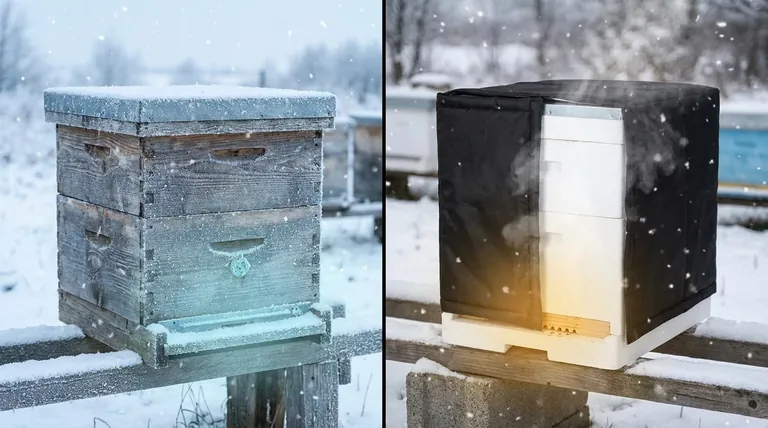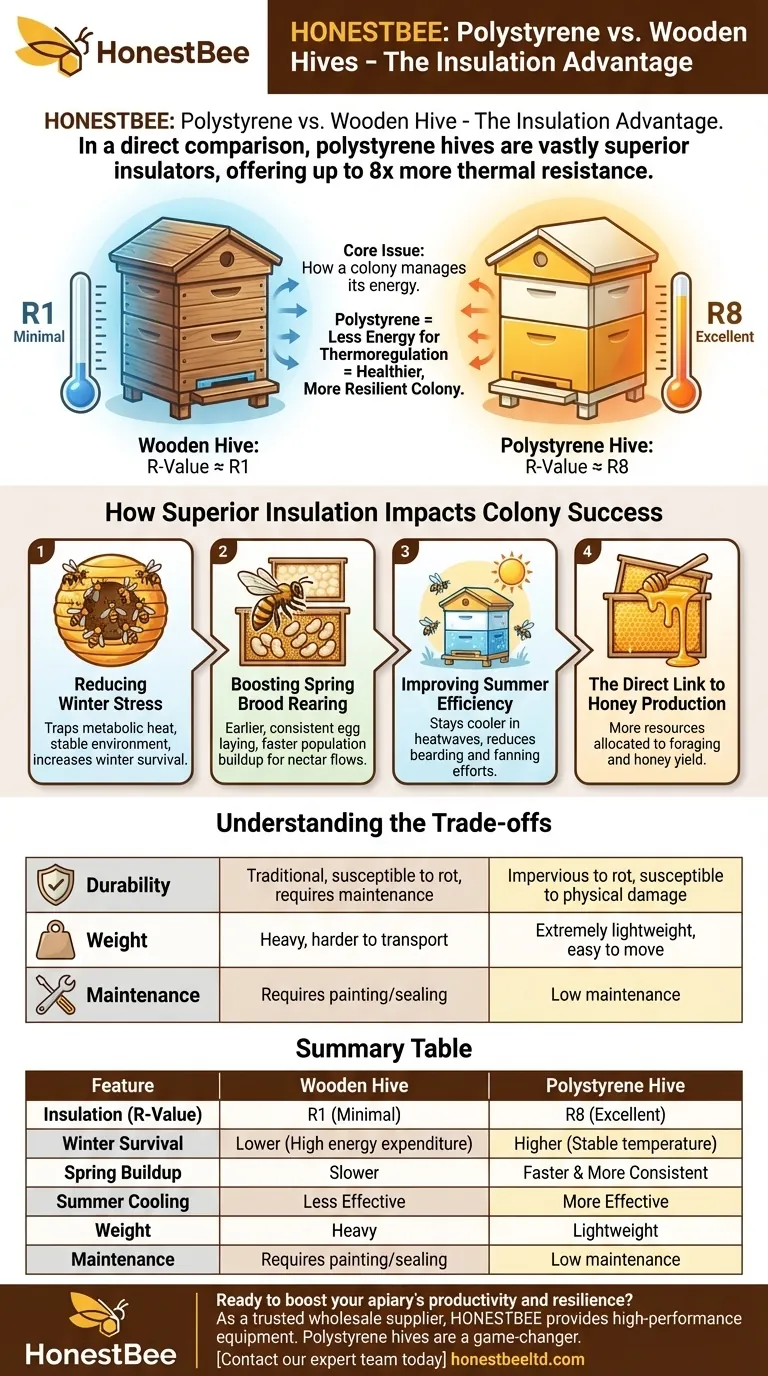In a direct comparison, high-density polystyrene hives are vastly superior insulators to traditional wooden hives. A standard wooden hive possesses an R-value of approximately R1, offering minimal thermal resistance. In contrast, a polystyrene hive of the same dimensions provides an R-value of around R8, making it up to eight times more effective at insulating the colony from external temperature fluctuations.
The core issue is not simply wood versus plastic, but how a colony manages its energy. Superior insulation from polystyrene drastically reduces the energy bees must expend on thermoregulation, directly translating to a healthier, more productive, and more resilient colony.

The Physics of Hive Insulation: R-Value Explained
The effectiveness of any hive material as an insulator is measured by its R-value. Understanding this simple metric is key to grasping the profound difference between wood and polystyrene.
What is R-Value?
R-value is a measure of a material's resistance to heat flow. A higher R-value means better insulation—the material is more effective at stopping heat from moving through it, keeping the interior warm in the winter and cool in the summer.
Wood's Modest Insulation (R1)
A typical wooden hive wall, usually about 3/4-inch thick, has an R-value of approximately R1. This provides only a minimal thermal barrier, similar to a single pane of glass. The colony must burn significant energy and food reserves to compensate for this heat loss.
Polystyrene's High-Performance Insulation (R8)
High-density Expanded Polystyrene (EPS), the material used in modern insulated hives, has an R-value of around R8. This level of insulation is comparable to the walls of an insulated cooler and is dramatically more effective at stabilizing the hive's internal temperature.
How Superior Insulation Impacts Colony Success
This eight-fold difference in insulating capability is not a minor detail; it fundamentally changes the challenges a honey bee colony faces throughout the year.
Reducing Winter Stress
In a wooden hive, the colony must form a tight cluster and constantly shiver their flight muscles to generate heat, consuming large amounts of stored honey to survive the cold. A polystyrene hive's insulation traps this metabolic heat, creating a much more stable and warmer environment. This reduces food consumption and dramatically increases winter survival rates.
Boosting Spring Brood Rearing
A stable, warm internal temperature allows the queen to begin laying eggs earlier and more consistently in the spring. The colony does not have to expend as much energy keeping the brood nest at its critical 95°F (35°C), leading to a faster population buildup and a stronger workforce for the first nectar flows.
Improving Summer Efficiency
Insulation also works to keep heat out. During intense summer heatwaves, a polystyrene hive stays significantly cooler than a wooden hive. This reduces the need for bees to perform "bearding" on the outside or expend energy fanning and evaporating water to cool the interior, freeing them up for foraging.
The Direct Link to Honey Production
By minimizing the energy spent on thermoregulation, the colony can allocate more resources and workforce to its primary tasks: raising brood, foraging for nectar, and producing honey. Healthier bees and a larger foraging force directly result in increased honey yields.
Understanding the Trade-offs: Beyond Insulation
While polystyrene is the clear winner on insulation, the choice of a hive is a practical decision involving several other factors.
Durability and Lifespan
Wood is a durable, traditional material but is susceptible to rot and warping if not properly maintained with paint or preservatives. Polystyrene is impervious to rot but can be damaged by careless handling with hive tools or by pests like wax moths if the colony is weak.
Weight and Portability
Polystyrene hives are extremely lightweight, often weighing less than a quarter of their wooden counterparts. This is a significant advantage for beekeepers who need to move hives for pollination or manage multiple apiaries.
Maintenance and Cost
Wooden hives require regular painting and upkeep to protect them from the elements. Polystyrene hives are generally lower maintenance. While the initial cost can be similar or slightly higher for polystyrene, many beekeepers find them more cost-effective over the long term due to increased colony survival and productivity.
Making the Right Choice for Your Apiary
Your decision should be based on your specific climate, beekeeping goals, and management style.
- If your primary focus is colony health and honey production, especially in climates with cold winters or hot summers: Polystyrene is the technically superior choice due to its massive insulation advantage.
- If your primary focus is a traditional aesthetic and using natural materials: Wood is the classic option, but be prepared to consider supplemental insulation like hive wraps during winter.
- If your primary focus is ease of handling and mobility: The lightweight nature of polystyrene makes it the undeniable winner for any beekeeper who frequently lifts or moves equipment.
Ultimately, choosing the right hive material is about providing your bees with the best possible environment to thrive.
Summary Table:
| Feature | Wooden Hive | Polystyrene Hive |
|---|---|---|
| Insulation (R-Value) | R1 (Minimal) | R8 (Excellent) |
| Winter Survival | Lower (High energy expenditure) | Higher (Stable temperature) |
| Spring Buildup | Slower | Faster & More Consistent |
| Summer Cooling | Less Effective | More Effective |
| Weight | Heavy | Lightweight |
| Maintenance | Requires painting/sealing | Low maintenance |
Ready to boost your apiary's productivity and resilience?
As a trusted wholesale supplier to commercial apiaries and distributors, HONESTBEE provides the high-performance equipment your operation needs to succeed. The superior insulation of polystyrene hives is a game-changer for colony health and honey yields.
Let us help you equip your business for maximum efficiency and profitability. Contact our expert team today to discuss your needs and explore our range of beekeeping supplies and equipment.
Visual Guide

Related Products
- Professional Insulated Winter Hive Wrap for Beekeeping
- HONESTBEE Advanced Ergonomic Stainless Steel Hive Tool for Beekeeping
- Telescopic Beehive Outer Cover Lid Roof with Galvanised Sheeting for Langstroth Hive and Beehive Outer Cover
- Professional Galvanized Hive Strap with Secure Locking Buckle for Beekeeping
- Professional Drop-Style Hive Handles for Beekeeping
People Also Ask
- How does insulation help bee hives in severely cold weather? Conserve Energy & Ensure Colony Survival
- Why is insulation important for hives during winter? Ensure Your Bees Survive and Thrive
- What are the steps to properly wrap a beehive for winter? Ensure Your Colony Survives the Cold
- Should bee hives be insulated? Protect Your Colony from Moisture, Not Just Cold
- Is it always necessary to insulate beehives? A Guide to Winter Survival & Colony Health



















